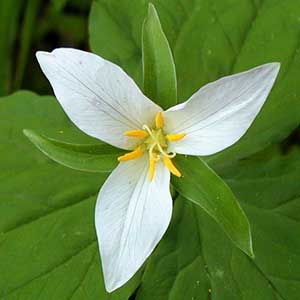Trillium ovatum
Trillium foetidissimum
Pacific trillium, trillium, western trillium, western wake-robin, western white trillium, white or western trillium, white trillium
fetid trillium, Mississippi River wakerobin, stinking trillium
semierect to horizontal, short, stout, praemorse.
horizontal, brownish, thick, short, praemorse, not brittle.
1–2, round, 2–5 dm, ± slender, glabrous.
1–2, green to maroon, round in cross section, 0.8–2.8 dm, papillose basally.
sessile, subsessile, or short-petiolate;
blade medium green, sometimes blotched and mottled, main veins prominent, ovate-rhombic, 7–12 × 5–20 cm, continuing to expand during anthesis, base rounded, apex acuminate.
often carried quite horizontally, well above ground, sessile;
blade light green or bronze-green, strongly mottled in dark green with central light green stripe, mottling becoming obscure with age but less so than in most species, elliptic-ovate, rarely ± orbicular, 6.7–12 × 3.8–6 cm, not glossy, base evenly tapered to broad attachment, apex obtuse-acute.
erect or nodding, odorless;
sepals spreading to horizontal, green, lanceolate to oblong-lanceolate, 15–50 × 6–20 mm, margins entire, apex acute;
petals erect-ascending, usually wide-spreading from base, exposing entire pistil, white or with pink or blush markings, lacking V-shaped markings, fading to rosy pink, purple, or dark red, veins not deeply engraved, ± linear to widely obovate, 1.5–7 ×1–4 cm, widest at or above middle, thin-textured, margins flat to undulate, apex acuminate;
stamens prominent, slightly recurved-spreading to straight, 10–18 mm;
filaments white, shorter than anthers, slender;
anthers yellow, 4–16 mm, slender, dehiscence latrorse-introrse;
ovary green or white, ovoid, 6-angled, 5–12 mm, attachment ± 3/4 ovary width;
stigmas recurved, barely connate basally, greenish white or white, linear, not lobed adaxially, 6–10 mm, uniformly thin;
pedicel erect to leaning, 2–6 cm.
borne directly on bracts, odor of putrid meat, especially when in strong sunlight;
sepals displayed above bracts, carried almost horizontally, green or green streaked with dark maroon, lanceolate, 16–40 × 4–6 mm, thick-textured, margins entire, apex acute;
petals long-lasting, erect, very gradually incurved from base to apex, ± connivent, ± concealing stamens and ovary, pinkish purple, light to reddish purple, brownish purple, rarely yellow, fading to brownish tones with age, not spirally twisted, not inrolling with age, veins not engraved, narrowly elliptic to linear-lanceolate, 2–5 × 0.3–0.5 cm, thick-textured, not glossy, margins entire, flat, acute at apex;
stamens relatively prominent, erect, 9–25 mm;
filaments dark maroon, 3–6 mm, dilated basally;
anthers straight, dark maroon-black, 8–15 mm, dehiscence introrse;
connectives straight, extended 1–1.5 mm beyond anther sacs;
ovary red-purple, ovoid, hexagonal in cross section, 5–12 mm, broadly attached;
stigmas erect, divergent-recurved, distinct, dark purple, subulate, nearly as long as ovary, fleshy.
baccate, green or white, ± odorless, broadly ovoid, obscurely winged, 1.2–2.8 × 0.7–1.9 cm, pulpy-moist.
purplish brown, ovoid, 6-angled at least apically, fleshy.
= 10.
Trillium ovatum
Trillium foetidissimum
Varieties 2 (2 in the flora).
(Discussion copyrighted by Flora of North America; reprinted with permission.)
Trillium foetidissimum seems tolerant of a wide range of soil moistures and types, from low, swampy woods to high, dry bluffs and ravine slopes. This is the only Trillium known to occur within its Louisiana range (J. D. Freeman 1975). Freeman considered it to be closely related to T. sessile.
(Discussion copyrighted by Flora of North America; reprinted with permission.)
1. Bracts sessile; petals lanceolate to obovate, 1.5–7 × 1–4 cm | var. ovatum |
1. Bracts distinctly short-petiolate; petals linear to linear-lanceolate, 0.5–2.4 × 0.2–0.6 cm | var. oettingeri |
- Local floras:
BC,
CA,
OR,
WA
- Local Web sites:
CalFlora,
CalPhotos,
Flora NW,
PNW Herbaria,
Turner Photog.
WildflowerSearch
iNaturalist (observations)
USDA Plants Database
- LBJ Wildflower Center
- SEINet
- Plants of the World Online
- Encyclopedia of Life
- Wikipedia
- Google Image Search


